Google is upping the ante in how it ranks websites. The world’s largest search engine already held website owners to standards of page speed, mobile-friendliness, and quality content. To ensure the best user experience possible, Google is adding a few new primary elements to its algorithms. Effective in June 2021, this new algorithm measures a different set of metrics by which it scores your website. Here are seven things you need to know about Google’s Core Vitals.

1. What Are Core Vitals?
When you hear the phrases Largest Contentful Paint (LCP), First Input Delay (FID), and Cumulative Layout Shift (CLS), it doesn’t sound very easy. But if you strip away the techie terms and drill down to the basics, it means Google will now check how long it takes for your page’s biggest piece of content to load, how long it takes your website to engage with user interaction, and how your site takes shape while the page is loading.
Google is looking at the loading time for content, interactivity, and visual stability of websites to determine which one it shows on the search engine results page (SERP).
The initial launch of Google’s Core Vitals is a work-in-progress as the internet powerhouse intends to evaluate and update the algorithms on a yearly basis to include more user experience (UX) metrics.

The Core Vitals, essentially, will determine, in part, where your website shows up in Google’s search results based on user experience.
These new factors in Google’s algorithms come above but in conjunction with mobile-friendliness, safe browsing, HTTPS, and no intrusive interstitials.
Bringing your knowledge of these new factors will continue to give you the upper hand over your competition.
Knowledge is power.
2. LCP – Largest Contentful Paint
Page speed is something Google has monitored on websites for some time. Now, it’s peeling back layers to look deeper – not just into overall page load time, but down to how long it takes the largest element on your page to load, whether that’s a block of text, an image (including background image loaded with CSS), video, heading tags, tables, lists, and other text block elements. How quickly the biggest piece of content loads on your page is what determines your LCP.
Google scores these elements as good, needs improvement, and poor. For LCP, you want a score of 2.5 seconds or less. If your score is between 2.6 and 4.0, then it falls under the category of “needs improvement.” And anything over 4.0 ranks as poor and will hurt your search engine authority. However, only 75 percent of page views need to be in the “good” category.
One thing that might cause a lag in LCP is a slow server or software. Browser software and plugins could also prove problematic. Another would be an abundance of JavaScript and CSS. Slow loading resources can also be an issue.
Knowing that your page is being written (either by yourself or someone you hire) with the most up-to-date code is a key factor in staying on the cutting edge of technology.
Be sure to talk to your web developer about the revisions that have happened since your page was deployed.
You’ll need to optimize your images and videos to make sure they’re not weighing your site down. If your images are too large, they bog down your page. If they’re too small, they end up pixelated and unprofessional.
“Lazy loading” is a setting you can apply to your website that doesn’t load images below the fold until the user scrolls. Once the user scrolls, the image appears instantly. Lazy loading can greatly increase webpage load time.
3. FID – First Input Display
Response time is what’s measured in FID – or how long it takes for the user to be able to engage with the website. For example, a user may go to a website and try to click a button, but the button is inactive and doesn’t work, usually due to something like a slow-loading ad or popup. Then, when the button does appear as functioning, it shifts on the page.
When someone has to wait for your website to become interactive, it lessens their experience, and Google keeps track.

JavaScript can also be a problem for FID. Improperly written code can cause your end users to experience a lag in loading, which in turn makes the page non-interactive until it finishes.
This FID metric is measured in milliseconds. A good score is considered 100 ms or less; 101-300 ms is considered needing improvement, and anything over 400 ms is considered poor. In general, you might think of 400ms as being very fast, almost to the blink of an eye. In technology, however, 400 ms would be considered a lifetime of waiting. Technology is at the forefront of every aspect of society. These response times have become the benchmark and the foundation. The bar is constantly being raised.
4. CLS – Cumulative Layout Shift
Sometimes, when pages load, the image, text, ads, and other elements shift and bounce around, popping up in the wrong place and then loading into its proper place when the site catches up with itself. This movement of elements negatively influences a user’s experience while they wait for your page to properly format.
CLS is often influenced by ads, which affect the stability of your site. Google wants to know how often that happens, and then it docks you for it.
Cumulative Layout Shift scores include 0.1 or less for a good score, 0.1-0.25 needs improvement, and anything over 0.25 is considered poor.
5. How to Track Core Vitals
In order for your website to perform well with Google’s Core Vitals, all three metrics, the LCP, FID, and CLS, must all be in the green.
There are several ways that you can and should track your Core Vitals to find areas for improvement.
Chrome UX Report: The Chrome UX report provides key information about the expectations of your users, as well as their frustrations, and helps you discover what areas of your website are working and which pages need to be revisited to meet the new metrics.
Chrome DevTools: Enabling Chrome DevTools to a browser allows developers to gain deeper insights into their browsers and web applications.

Lighthouse: Lighthouse, an open-source automated tool, works to improve your web pages’ quality, checking for performance, accessibility, SEO, and more.
PageSpeed Insights: PageSpeed Insights is another tool in the Google toolbox for measuring your website’s performance on mobile and desktop. Google’s PageSpeed Insights is powered by Lighthouse, a Google open-source tool that runs various audits.
Search Console: In keeping with the overhaul of Google’s analytics based on user experience, Search Console now includes reports on Core Vitals.

Web Vitals Extension: This website plugin mimics the metrics measured by chrome for instant feedback on load time, interactivity, and visual stability.
6. Core Vitals and Bounce Rates
Each one of these Core Vitals metrics contributes to your bounce rates. A bounce rate is when a viewer clicks onto your site and then immediately leaves, either because it didn’t load properly or because the content wasn’t valuable.
High bounce rates lower your website’s search engine authority. To improve bounce rates, make sure your pages are fully search engine optimized, including Core Values, and that your content is valuable.
7. Content is Still King
Search engine optimization is there to support quality content. Google wants to deliver the most appropriate, valuable, and user-friendly website possible. You can spend eons working on your website’s SEO and Core Vitals, but without the right content, you’ll still lose your place on the SERP.

Create web content and blog posts that provide useful information to your viewers that solves a problem they’re having or makes their life easier in some way. For example, a real estate agent might publish a series of blog posts for buyers about the steps to buying a house, the basics of a home mortgage, closing costs for buyers, and other related topics. Without that critical element of quality content, your other metrics lose their bearing.
Publish content as often as you can, weekly at the least. Keeping your website updated with regularly published content signals to Google that the lights are on and somebody’s home. It also keeps your viewers coming back for more.
Conclusion
Google is all about user experience, and it’s holding websites accountable. Your page has to load quickly, be mobile responsive, and secure, but now it also has to account for the way users are perceiving and engaging with your content.
To improve your LCP, FID, and CLS, reduce JavaScript and CSS. If your code cannot be removed due to functionality, remember to verify that you are using the most up-to-date configuration for the best results. Optimize and compress images, and then implement lazy loading. And, if your server is the problem, see if you can amp up server speed.
But remember, you’re not creating content for Google; you’re publishing it for real people. Quality content comes first, and then search engine optimization, including Google’s new Core Vitals.

